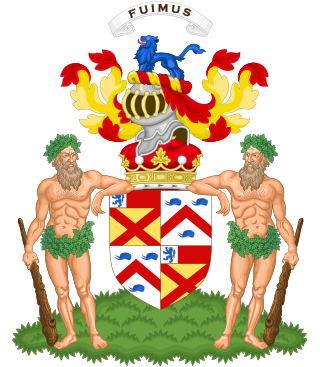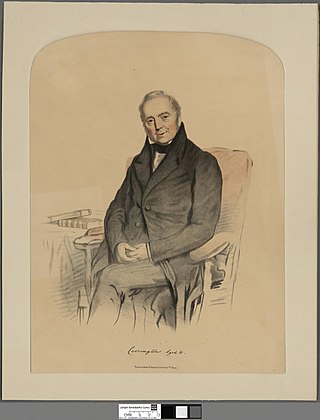
Marquess of Normanby is a title that has been created twice, once in the Peerage of England and once in the Peerage of the United Kingdom. The first creation came in 1694 in the Peerage of England in favour of John Sheffield, 3rd Earl of Mulgrave. He was a notable Tory politician of the late Stuart period, who served under Queen Anne as Lord Privy Seal and Lord President of the Council. In 1703 this first Marquess of Normanby was further honoured when he was made Duke of Buckingham and Normanby. These titles became extinct on the death of the 2nd Duke in 1735.

Earl of Carlisle is a title that has been created three times in the Peerage of England.

Marquess of Ailesbury, in the County of Buckingham, is a title in the Peerage of the United Kingdom. It was created on 17 July 1821 for Charles Brudenell-Bruce, 2nd Earl of Ailesbury.

Viscount Falmouth is a title that has been created twice, first in the Peerage of England, and then in the Peerage of Great Britain. The first creation came in the Peerage of England in 1674 for George FitzRoy, an illegitimate son of King Charles II by Barbara Villiers. He was created Earl of Northumberland at the same time and in 1683 he was made Duke of Northumberland. However, he left no heirs, so the titles became extinct at his death in 1716.

Earl of Wharncliffe, in the West Riding of the County of York, is a title in the Peerage of the United Kingdom.

Earl of Harewood, in the County of York, is a title in the Peerage of the United Kingdom.

Earl of Selborne, in the County of Southampton, is a title in the Peerage of the United Kingdom. It was created in 1882 for the lawyer and Liberal politician Roundell Palmer, 1st Baron Selborne, along with the subsidiary title of Viscount Wolmer, of Blackmoor in the County of Southampton. He had already been made Baron Selborne, of Selborne in the County of Southampton, in 1872, also in the Peerage of the United Kingdom. Both his son, the second Earl, and grandson, the third Earl, were prominent Liberal Unionist politicians. The latter was in 1941 called to the House of Lords through a writ of acceleration in his father's barony of Selborne. The third Earl's grandson, the fourth Earl, served as one of the ninety elected hereditary peers that remain in the House of Lords after the passing of the House of Lords Act 1999, and sat as a Conservative. As of 2021, the titles are held by the latter's son, the fifth earl, who succeeded his father in that year.
Viscount Hampden is a title that has been created twice, once in the Peerage of Great Britain and once in the Peerage of the United Kingdom. The first creation came in the Peerage of Great Britain when the diplomat and politician Robert Hampden, 4th Baron Trevor, was created Viscount Hampden, of Great and Little Hampden in the County of Bedford on 14 June 1776. The title of Baron Trevor, of Bromham, had been created in the Peerage of Great Britain in 1712 for his father, the lawyer Sir Thomas Trevor. Both titles became extinct in 1824 on the death of the first Viscount's second son, the third Viscount.

Viscount Ridley is a title in the Peerage of the United Kingdom. It was created in 1900 for the Conservative politician Sir Matthew White Ridley, 5th Baronet, Home Secretary from 1895 to 1900. He was made Baron Wensleydale, of Blagdon and Blyth in the County of Northumberland, at the same time, also in the Peerage of the United Kingdom. The latter title was a revival of the barony held by his maternal grandfather James Parke, Baron Wensleydale, whose title became extinct upon his death since none of his sons survived him.

Viscount Runciman of Doxford, of Doxford in the County of Northumberland, is a title in the Peerage of the United Kingdom. It was created in 1937 for the Hon. Walter Runciman, a politician whose career included service as a Member of Parliament, President of the Board of Trade and Lord President of the Council. He was the son and heir apparent of the shipping magnate and Liberal politician Walter Runciman, who had been created a Baronet in the Baronetage of the United Kingdom in 1906 and Baron Runciman, of Shoreston in the County of Northumberland, in 1933, also in the Peerage of the United Kingdom. As his father was still alive at the time of the creation of the viscountcy the title of this peerage was Runciman of Doxford rather than simply Runciman. As of 2020 the titles are held by the first Viscount's great-grandson David, the fourth Viscount, who succeeded his father in 2020. He is a well-known political scientist at the University of Cambridge.

Viscount De L'Isle, of Penshurst in the County of Kent, is a title in the Peerage of the United Kingdom. It was created in 1956 for William Sidney, 6th Baron de L'Isle and Dudley (1909–1991).

Baron Carrington is a title that has been created three times, once in the Peerage of England, once in the Peerage of Ireland and once in the Peerage of Great Britain.
Baron Gisborough, of Cleveland in the County of York, is a title in the Peerage of the United Kingdom.

Bywell is a village and civil parish in Northumberland, England. It is situated on the north bank of the River Tyne opposite Stocksfield, between Hexham and Newcastle. The parish has a population of around 380 and Newton to the north is now its most populous settlement.

Wentworth Henry Canning Beaumont, 2nd Viscount Allendale, was a British peer, Lord Lieutenant of Northumberland, and army captain.

Wentworth Canning Blackett Beaumont, 1st Viscount Allendale PC, JP, DL, styled The Hon. Wentworth Beaumont between 1906 and 1907, and Lord Allendale from 1907, was a British Liberal politician.

Wentworth Blackett Beaumont, 1st Baron Allendale, was a British industrialist and Liberal politician.

Colonel Thomas Richard Beaumont of Bretton Hall, Wakefield, Yorkshire, was a British Tory politician and soldier.

Thomas Wentworth Beaumont of Bretton Hall, Wakefield in Yorkshire, and of Bywell Hall in Northumberland, was a British politician and soldier. In 1831, at the time he inherited his mother's estate, he was the richest commoner in England.
Julian Charles Marsham, 8th Earl of Romney, is an English peer.














